
Salt and Pepper Shakers
Salt and pepper are staples at restaurants in the kitchen and at individual tables. From mills to salt and pepper shakers, the options available to dispense your most popular seasonings are as vast as your menu offerings. However, salt and pepper shakers are much more intricate than they appear. Knowing your establishment's style and customers' preferences ensures your signature culinary creations are seasoned perfectly every time.
Shop All Salt and Pepper Shakers and Mills
Use the following links to learn more about salt and pepper shakers:
Salt and pepper mills grind rock salt crystals, sea salt, and peppercorns into a fine powder to disperse over dishes. While both are commonplace in many restaurant kitchens, salt and pepper mills might be placed on diners' tables in high-end establishments for a more elegant dining experience. However, they require more attention and maintenance than a simple salt or pepper shaker. You must maintain these mills to ensure they remain in working order for customers and kitchen staff.
Are Salt and Pepper Mills Interchangeable?
While salt and pepper mills may look identical, they are rarely interchangeable. Due to salt's corrosiveness and peppercorns' toughness, each mill requires a different grinding mechanism material. Salt mills typically use ceramic or nylon grinders that will not corrode over time. In contrast, pepper mills use carbon or stainless steel to effortlessly grind tough peppercorns without damaging the mechanism. Since peppercorns are non-corrosive, the steel is long-lasting and keeps your pepper mill functioning at its best.
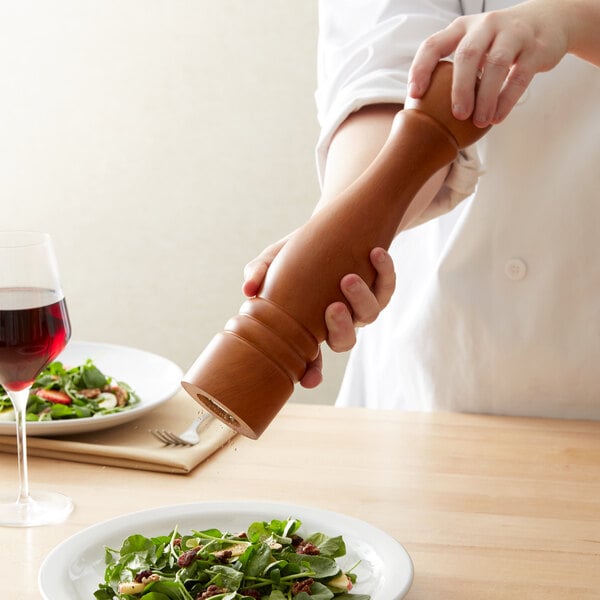
How to Use Salt and Pepper Mills
Whether grinding salt or pepper, mills are incredibly easy to use. First, fill the mill with either coarse salt or whole peppercorns. Make sure to use the product the mill is supposed to dispense. Not all pepper mills can use salt, and vice versa.
Adjust the grind coarseness to the desired texture. Typically, loosening or tightening the knob at the top of the mill will ensure a larger or finer grind, meeting your customers' preferences. To allow easy tightening adjustments to create the finest ground seasonings possible, turn the unit upside down before tightening to eliminate the opportunity for peppercorns to catch inside the mechanism that prevents a complete closure.
How to Turn Salt and Pepper Mills
Salt and pepper mills are designed to be intuitive for both kitchen staff and customers. To turn the mill, hold it in one hand several inches above the food you want to season. Then, use the other hand to twist and grind the salt crystals or peppercorns. As you turn the mill, the ground spice will fall from the bottom of the mill onto the food below.
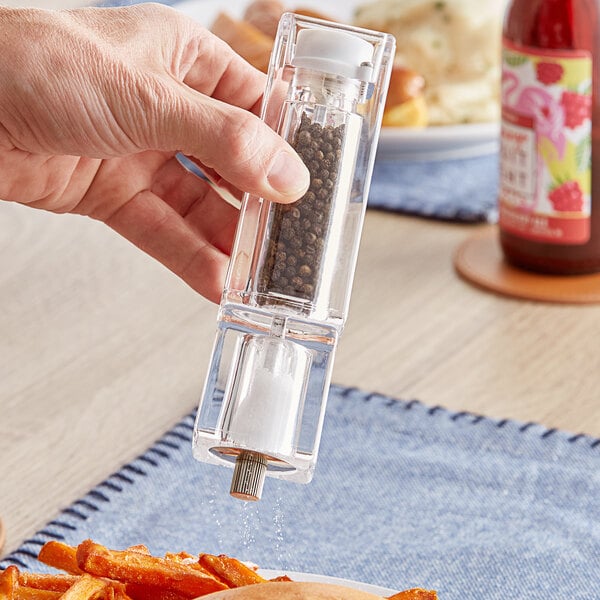
How to Refill Salt and Pepper Mills
Refilling salt and pepper mills takes a matter of seconds. Check out these simple steps to fill a salt and pepper mill.
- Remove the top knob by turning it counterclockwise.
- Once removed, lift off the top of the mill to access the spice chamber.
- Fill the chamber 3/4 full for best performance, then reassemble. Filling to this level will decrease the amount of torque on the grinding mechanism, making for an easier and more comfortable grind.
- If your establishment is in a humid climate, provide extra space in the spice chamber to allow for the swelling of peppercorns.
Salt and pepper shakers allow for fast, inexpensive, and efficient dispersion of seasonings. Since salt and pepper shakers often look identical, it can be difficult to tell the difference between them. Some salt and pepper shakers are distinguishable by a printed "S" or "P" indicating which is which. Others are not as simple.
When in doubt, check the number of holes in the top of the shaker. In the United States, restaurants traditionally use the shaker with fewer holes for salt to limit salt intake. In other regions of the world, this may be swapped, with more holes meaning salt and less for pepper.
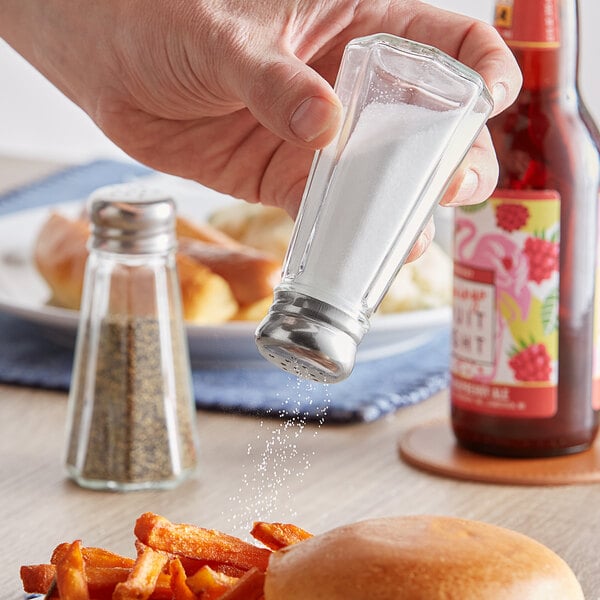
Why Do People Put Rice in Salt Shakers?
A pain point for customers is when no salt comes out of a full salt shaker. In a humid climate, salt tends to absorb water from the air, resulting in clumping. Adding rice grains into the shaker will absorb the moisture first, leaving the salt free to flow out of the shaker. For standard salt shakers, a half teaspoon of rice typically works best.
There are three types of grinding mechanisms for salt and pepper mills. Grinding mechanisms are available in nylon, stainless steel, or ceramic materials. Each has its benefits and limitations, including what it can grind, how durable it is, and how expensive the material makes the mill.

- Nylon grinders: Typically used for salt, nylon grinders resist corrosion but lack the durability of other grinding mechanism materials.
- Steel grinders: Due to their durability and efficiency, stainless steel grinders are perfect for peppercorn mills. However, they are prone to corrosion and should not be used with salt.
- Ceramic grinders: Often considered the best of the three materials, ceramic grinders are durable, sharp, and naturally resistant to corrosion. They are ideal for salt and pepper mills.
How to Fix a Salt or Pepper Mill Jam
Follow these steps to learn how to fix a salt or pepper mill jam.
- Turn the spice mill upside down and shake the spice down to the top.
- Give the bottom of the mill several light taps.
- If your spice does not rattle loosely, your mill may have been overfilled or exposed to moisture. Remove seasonings from the mill, then refill 3/4 of the way full.
Caring for salt and pepper mills and shakers depends primarily on the mills' materials. Shakers require little maintenance. Wash them in warm, soapy water and fully dry each element to prevent corrosion and salt and pepper clumps. Salt and pepper mills require more careful ministrations, especially when cleaning the grinding mechanism. Instead of dunking the mill in water, carefully clean each piece with a wet cloth and dry thoroughly with another fresh cloth.
Wooden salt and pepper mills are more susceptible to damage than their glass or metal counterparts. Follow these tips to clean and care for your wooden salt and pepper mills.
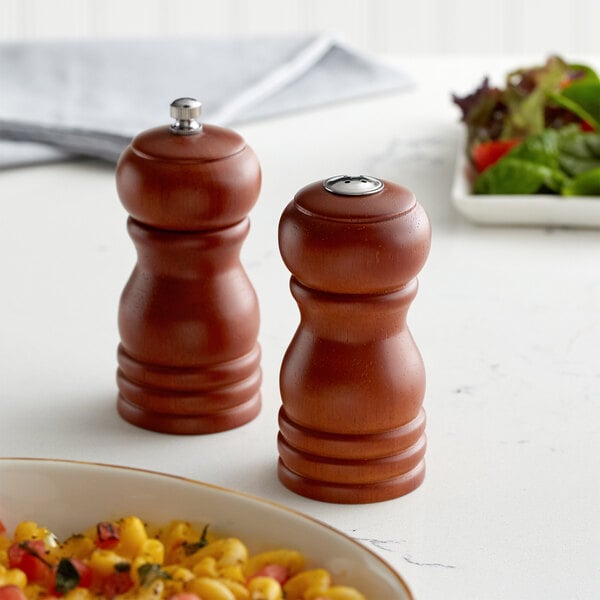
- To clean wooden shakers or mills, wipe clean with a damp cloth or polish with a soft cloth. Make sure each part is dried thoroughly to prevent damage.
- Do not use alcohol, strong detergents, abrasives, or any kind of solvents to clean the shaker or mill.
- Do not immerse the shaker or mill in water or a dishwasher.
- To restore a wooden shaker or mill, apply a wood conditioner with a soft cloth or paper towel after cleaning it. Once the conditioner has soaked into the shaker or mill, buff off any excess with a clean cloth.
- Avoid exposing your shaker or mill to extreme heat or extreme cold. Extreme temperatures may damage the product finish and flavor of the spices.
Related Resources

Types of Salt
Salt is an essential ingredient in countless dishes, adding flavor and enhancing the taste of culinary creations. However, not all salt is created equal. There are several different types of salt available on the market, each with its own unique characteristics and uses. From the delicate flakes of sea salt to the bold flavor of kosher salt, we'll explore the different types of salt, their distinctive qualities, and the best applications for each variety. Shop All Salt and Pepper Use the following links to learn more about a specific type of salt: Types of Sea Salt Types of Rock Salt Types of Fine Salt Types of Cleaning Salt

Types of Chinaware
Whether you're a restaurant owner , event planner, or caterer , identifying what china to purchase can be difficult. Making the right choice can elevate your serving experience and leave a lasting impression on your guests, while the wrong choice can negatively impact your service. China varies in shape, size, and color, presenting a wide range of options. Continue reading to learn about the different types of china, what sets them apart, and the details to take into account before you make a purchase. Shop All China Dinnerware Use the following links to skip to china information that most interests you: Types of Dinnerware What Is Fine China? What Is Vitrification? How to Store China How to Clean China How Much China Do I Need? China Purch
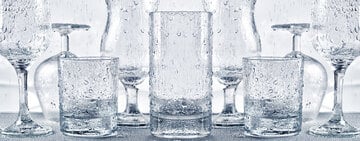
Bar Glass Cleaner Guide
In a properly cleaned glass, beer should produce a 1/2" to 1" tall head. This means you would only need to fill a 16 oz. glass with 14 oz. of beer, translating to more glasses per barrel and more profit for you! To achieve the best beer service possible, make sure you have an effective bar glass cleaner and warewashing process.
- Topics 1346
- Industrial 55
- Troubleshooting Guides 21
- Restaurant Management 128
- Bar Management 55
- Catering Tips 35
- Bakery Management 42
- Food Trucks & Concessions 49
- Advertising & Marketing 37
- Eco-Friendly Tips 11
- Facility Layout & Design 41
- Coffee Shop Tips 28
- Installation & Maintenance 51
- Janitorial & Pest Control 30
- Safety & Sanitation 88
- Startup Tips 104
- Menu Design 10
- Kitchen & Cooking Tips 81
- Hospitality Management 23
- Pizza & Sandwich Shop Tips 36
- Smallwares 37
- Food Prep 88
- Tabletop Items 17
- Disposables 22
- Calculators & Tools 6
- Consumables 52
- Warewashing & Laundry 18
- Cooking Equipment 90
- Food Storage & Refrigeration 51
- Beverage Equipment 34
- Office Supplies 6
- Resource Type
- In-Depth Articles272
- Buying Guides296
- How-Tos93
- Product Reviews77


